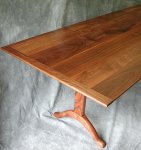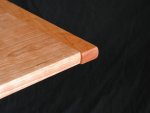Hey Frank,
If you have a table with your boards running the long way, then the ends will show end grain.


If that bugs you, you can put a board going across the width of the end to hide the end grain.
Have no idea why its called a bread board.
QUOTE]
Jesse, when I grew up, (before the days of "Instant Everything",

EVERYONE had a Breadboard in their kitchen, and that was the way they were all made. Kind of like today most everyone has a Cutting board, (and most folks back then had one of those too of some fashion or other), but the Breadboard was usually about 2 feet square, and was ONLY used to roll out bread dough, pie crusts, etc. Glues weren't as good back then, and since a lot of the boards were washed regularly, the ends were "Pinned" and that was what kept them together when the glue failed. (I never saw anyone take them apart and reglue them).
Since that was how they were all made, I "Suspect" that the name just carried over from some point in time.



